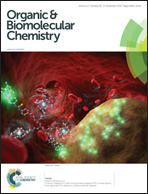First principles calculation of electron ionization mass spectra for selected organic drug molecules†
Abstract
This study presents a showcase for the novel Quantum Chemistry Electron Ionization Mass Spectrometry (QCEIMS) method on five FDA-approved drugs. The method allows a first-principles electronic structure-based prediction of EI mass spectra in principle for any molecule. The systems in this case study are organic substances of nominal masses between 404 and 853 atomic mass units and cover a wide range of functional groups and organic molecular structure motifs. The results demonstrate the widespread applicability of the QCEIMS method for the unbiased computation of EI mass spectra even for larger molecules. Its strengths compared to standard (static) or database driven approaches in such cases are highlighted. Weak points regarding the required computation times or the approximate character of the employed QC methods are also discussed. We propose QCEIMS as a viable and robust way of predicting EI mass spectra for sizeable organic molecules relevant to medicinal and pharmaceutical chemistry.


 Please wait while we load your content...
Please wait while we load your content...